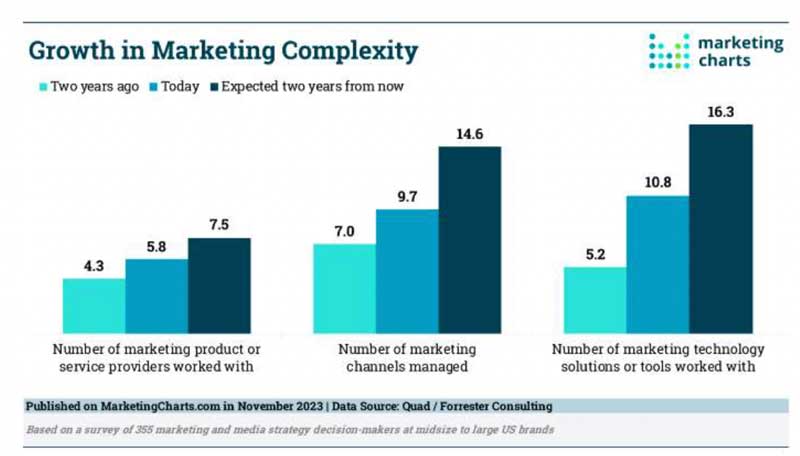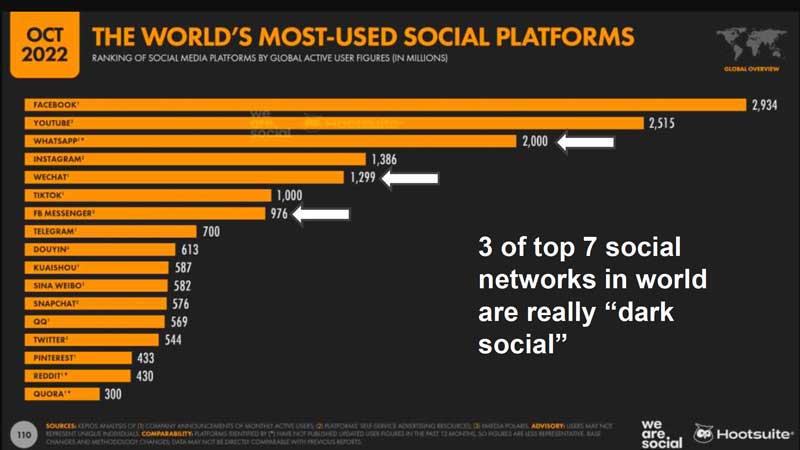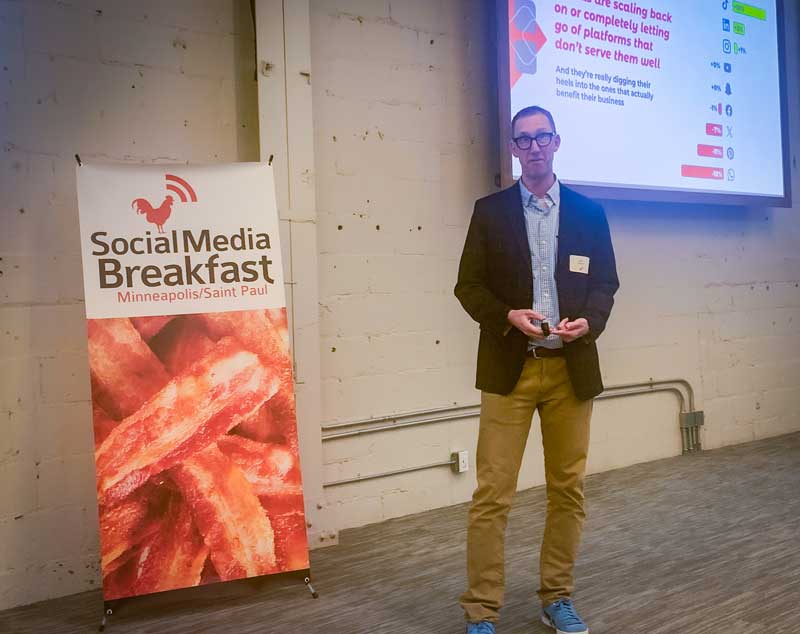Social Media Trends for 2024
I compiled this annual look at social media trends for marketers, curious business owners, and casual users of any social media property. In this second-annual report, I took the work of Minneapolis-based industry expert Arik Hanson, added insight from marketing leader and author Mark Schaefer, and tossed in our own wisdom as social media users and insiders in power equipment. I boiled it all down to six ideas – let’s get to it.
Focus To Create Community
Every business, from large enterprise to local retailer, faces increasingly complex marketing choices today. A 2023 study by research and consulting firm Forrester shows that marketers manage twice the number of marketing channels today compared to 2021, and they use three times as many marketing technology tools. That’s unsustainable, according to Arik Hanson. “We are starting to see brands cutting out some social media platforms,” he said.
Find the channels your customers prioritize. And cut out the rest. Some brands have moved away from Twitter in its transition to X and found the discontinuation caused little if any negative impact.
Go Dark
Your focus should be on creating community wherever your community exists – even if that’s a non-traditional social platform. “It may be time for dark social media,” said Hanson. Dark social platforms are those private forums whose traffic can’t be measured by traditional analytics tools. (Not the dark web; that’s a different beast). Private groups like Discord, What’s App, Facebook Messenger, even email, can be considered “dark” platforms. What’s App is the third most used media platform in the world, ahead of Instagram and TikTok.
People want to belong to a community, and they use specific social platforms to do that. As a marketer, find that place where you can activate your community. “Social media is not a strategy,” said Mark Schaefer. “It’s the beginning of a process that leads to community. Those who can bring people together in community can create a deep and lasting emotional connection … the goal of your brand.”
Be Authentic To Build Trust
The idea of “authenticity” in social media has been alive for a few years now, with user-generated content (UGC) often at the forefront. Today, artificial intelligence, even in its infancy, will create a stronger need for authenticity across the internet. This goes beyond UGC and opens up a world of realism and personal expression that can succeed as opposition to machine-generated content. Consider two areas of focus.
First, post what you can without worrying about high-production editing and design details. Think of social media more as conversation and less as marketing. You’ll be able to post more frequently, and your audience will appreciate the simplicity and honesty.
Second, post with more personality, less like a brand trying to sell something. Social-media expert Hanson points to a trend he’s witnessed on LinkedIn, where professionals are delivering more personal messages more frequently. Part of that is because working from home means that LinkedIn is the new office break room. But it also signals a shift to more transparency on social media in general. You don’t have to appear perfect on Instagram, or ultra-professional on LinkedIn. Be you, wherever you post.
Author Mark Schaefer presents this idea a bit differently. “Creators are the media,” said Schaefer in his social media trends post. Schaefer points to a report published by the Interactive Advertising Bureau, a trade association for digital marketing, saying 39% of consumers are watching more creator content than a year ago. “Can you imagine any other media property getting a 39% boost in one year?” Schaefer asks. “The impact, reach, and influence of creators is exploding and yet an influence strategy is not even on the radar yet for most companies.”
And it’s exploding on TikTok, YouTube, Instagram and other social media platforms. That means anyone and any business can be a creator and tap into this community-building wave.
Set Your Sights On Search, Not Likes
We have built our social media measurement habits around Likes, Follows, and Views, all under the umbrella of “Engagement.” Arik Hanson points out that engagement rates for nearly all social platforms keep dropping. The average engagement rate for a Facebook post (organic, not paid) is around 1 percent. Plus, Hanson’s own research shows that people don’t click on links in social media. Look at the referral traffic on your own website through your analytics tools.
What should you do? Stop posting and measuring for declining, and often meaningless, engagement. Start using social media for the search tool it is increasingly becoming. Larger numbers of Gen Z use TikTok, Instagram and even YouTube to search for products and discover brands.
Schaefer backs up this idea. “Everyone seems to be focused on how AI will change the game for search,” he wrote. “But nobody seems to be noticing a much more significant and non-obvious trend. According to information from Statista, Gen Z is now conducting almost as many product searches on social media as Google.”
This trend is way beyond the world of celebrity influencers. Sure, lifestyle brands with loads of money will still use athletes and movie stars for pitching. But more brands today collaborate with micro-influencers – people whose followers measure in the 1000s, not the millions – and niche users. That’s a trend that OPE dealers can take advantage of. And it’s certainly one that equipment brands are using, including Echo Tools with its Echo Means Business initiative.
This is not limited to Gen Z audience. Schaefer points to a study by international consumer research company GWI which reports in a 57 percent rise in baby boomers using TikTok since Q2 2021. “And they’re more likely to have bought a product or service online in the last week than Gen Z,” Schaefer adds.
Be Shoppable
Speaking of shopping, Schaefer predicts social media platforms, in 2024, will “continue to become popular shopping outlets for consumers.” He points to a HubSpot survey showing 22 percent of social media users purchased a product directly from Instagram, followed by 21 percent of consumers who bought directly on Facebook.
He adds that by 2026, global social commerce sales will reach a whopping $6 trillion, with the U.S. having approximately 108 million social buyers by 2025. Schaefer also points to an ecommerce trend that has begun to blossom in Asia called “live commerce.” It combines influencer, livestreaming, and impulse buying and he expects the rest of the world to join in.
While ecommerce in general can be a sensitive topic for some OPE dealers, shoppers are increasingly comfortable with the idea, especially for smaller-priced consumable items, apparel and accessories.
Entertain, Then Educate
Marketers have long thought their job is to educate, and mostly about product features and sale prices. Many have done mostly the same on social media, touting sales promos and new product bullet points. It’s time to market it differently, according to Hanson, especially on social.
“Entertain, then educate,” he said. “Or just entertain.” Here he repeats his own study saying that link-sharing is ineffective on social media. He also states (and he’s not alone here), that sharing branded graphics does not work on social. Those artfully designed images that include a store logo, a product image, and a few feature points in too-small type – those images just don’t work on Instagram, Facebook, or even LinkedIn.
Hanson suggests marketers should entertain their audiences on social media. Have fun and be funny, he states. Whether for a B2C or a B2B audience, social media use is less about education and more about entertainment. Savvy marketers can combine the two. That’s why you see so many landscape professionals sharing eye-catching videos as they stripe their customers’ lawns. It’s entertainment with a little bit of education.
Random social media thoughts for 2024
- It’s all about the comments, according to Hanson. One of the best ways to build community on social media is to encourage commenting, and respond to every comment.
- Nothing will replace Twitter, said Hanson. Threads is close, but it’s not the same. Reserve any brand handles you can on Twitter competitors like Threads and Bluesky.
- YouTube Shorts is a good place for repurposing existing content, said Hanson. But be realistic – impressions and views might not be huge.
- Influence is everything, said Schaefer. The marketing world is in a state of massive transition. Advertising is less visible in a streaming media world and more expensive than ever. Brands will increasingly spend money on influences. A product placement with Mr. Beast might have bigger reach than an ad on the Super Bowl.







